100+ Best Places to Visit in Australia!
If you are searching for a higher climate, Australia is one of the most satisfactory locations inside the globe to break out of the cold climate.
Situated inside the Southern Hemisphere, it offers lots of sunshine, clear skies, and the most relaxed temperatures precisely during the iciness season.
It is a dramatic aggregate between infinite crimson-colored arid landscapes, some of the oldest tropical rainforests on Earth, terrific white-sand seashores, turquoise clear waters, and Mediterranean attractions.
Australia is domestic to some of the maximum excellent-looking animals on Earth.
The variety of marine creatures is also enormous, especially in the largest coral reef on the planet, which stretches along the entire northeast Pacific coast.
With such a great variety of places to see and things to do, it’s really hard not to miss something interesting. To make it easier for you, we have listed 100 of the best places to visit in Australia:
8+ REASONS TO VISIT MALAYSIA
100+ BEST PLACES TO VISIT IN THE USA!
3 ASTONISHING SAILING ROUTES ACROSS THE WORLD!
HOW TO BE SUCCESSFUL WITH LUXURY RENTAL PROPERTIES!
HISTORY OF TAJ MAHAL OF INDIA!
BRUNEI CROWN PRINCE TO MAKE OFFICIAL VISIT TO SINGAPORE ON AUG 3!
THE BEST PUBLIC SWIMMING POOLS AROUND THE WORLD!
1. McKenzie Lake, Fraser Island (QLD)

Lake McKenzie is located in the middle of the dense rainforest that completely covers the largest sandy island on Earth.
3.6 miles (5.8 km) off the coast of Fraser Island, it is known for its pure snow-white silica sand beaches and crystal clear turquoise shoals.
The fresh water in the lake is so clear and transparent that only 3 species of fish can survive here!
At the same time, the 5-meter-deep lake is a paradise for beachgoers, swimmers and snorkelers.
The water temperature is comfortable for swimming all year round, ranging between 72°F (22°C) in August and 81°F (27°C) in February.
2. Fraser Island’s Maheno Wreck (QLD)

Dozens of shipwrecks have been recorded over the years along the coast of Fraser Island.
Rough seas, dangerous currents, shallow waters, and sudden tropical storms are among the reasons behind the remains of a number of steel ship skeletons along the coast.
The most interesting of them is the 5,000-ton ocean liner S.S Maheno that was thrown on the central east coast of Fraser Island during a powerful cyclone on July 7, 1935.
Nowadays, the skeleton of S.S Maheno attracts thousands of tourists per year.
However, visitors are advised to stay at least 3 meters away from the steel construction for security reasons.
3. Springbrook National Park (QLD)

Situated 37 miles (59 km) southwest of Gold Coast and 67 miles (108 km) south of Brisbane, Springbrook National Park is one of the most visited in Australia.
It covers 23.8 sq mi (61.56 km²) in the southeasternmost part of Queensland, right next to the border of New South Wales.
Here you can see one of the oldest subtropical rainforests in the world.
A few of the most beautiful Australian waterfalls are here too, including the outstanding Twin Falls.
Another recommended tourist attraction is the Natural Bridge on Cave Creek, where a small waterfall has dug an extraordinary-looking cave into the rock beneath.
4. Heart Reef (QLD)

Discovered for the first time in the 1970s, Heart Reef is one of the most extraordinary and easily recognizable coral formations not only in Australia but in the world as a whole.
You will find it less than 50 miles (around 80 km) off the coast of Queensland and less than 30 miles (48 km) east of the Whitsunday Islands.
Although the place is fantastic for diving and snorkeling and the waters are among the clearest in the world, the only way to enjoy the unusual shape of the coral formation is from the air.
5. Whitsunday Island (QLD)

Known for its extraordinary white silica sands, Whitsunday Island is one of the very best tropical beach destinations on the planet.
Situated in the Coral Sea, right off the central coast of Queensland, the island (and the archipelago of the same name) is covered with lush tropical rainforests and is surrounded by some of the most irresistibly blue waters in the world.
The warm limpid shallows are home to more than 200 species of sea creatures, including corals, fishes, and sea mammals.
6. Hamilton Island (QLD)

Famous for its superb white silica sands, shallow turquoise waters, palm groves and 365 days of fantastic weather per year, Hamilton Island is the most visited island destination in the country.
Located 15 miles (24 km) from Airlie Beach, just off the mainland coast of Queensland, it is a paradise for beachgoers, swimmers, snorkelers, and sunseekers.
It is quite popular for its mirrored waters and underwater visibility of over 130 ft (40 meters)!
Water temperatures are very comfortable, raining between 75°F (24°C) in winter and 84°F (29°C) in summer.
The island offers a wide choice of things to do and all kinds of upscale accommodation options.
7. Uluru (NT)

Located in the Red Center of Australia better known as Outback, Uluru is the largest rock monolith of its kind in the world.
Composed mostly of a type of red sandstone, its prominence is 1,142 ft (348 m) above the surrounding landscape and reaches 2.2 miles (3.6 km) in its longest part.
As it is located in the middle of the desert, Uluru is known for the great contrast between day and night temperatures.
During the day the weather is very hot in summer and pleasantly warm in winter, but the nights are quite often freezing.
In 1987, Uluru was included in the UNESCO World Heritage List.
8. Apostles (VIC)

Situated along the coast of Victoria, about 171 mi (275 km) southwest from Melbourne, “The Twelve Apostles” are one of the most popular and visited tourist attractions of Australia.
The powerful erosion in the region has been sculpting them over the last 20 million years.
The majestic limestone rocks and bridges are up to 160 ft (50 m) tall.
They fall within the limits of the Port Campbell National Park, and despite their name, there are only 8 rocks left.
9. Rainbow Valley Conservation Reserve (NT)

Situated about 45 miles (72 km) south of Alice Springs, the Rainbow Valley Conservation Reserve is a semi-arid area that is of great importance to the Australian Aboriginal people.
The main landmark here is the unique and fragile red-colored sandstone rocky formation, which is easily recognizable and is especially beautiful during the golden hour before sunset.
Being quite close to the main road, this is an ancient archaeological site which is deeply recommended to visit. The conservation reserve was founded in 1990.
10. Lake Hillier (WA)

Situated right next to the north shore of Middle Island (one of the islands of the Recherche Archipelago that lies off the coast of Western Australia), Lake Hillier is one of the most extraordinary-looking lakes in the world.
It is known for its bright bubblegum-pink color and level of salinity which is nearly the same as the level in the Dead Sea.
In fact, Australia is home to a few of the pink lakes in the world but this one is considered to offer the most saturated pink color.
It covers 15 ha (37 acres) and is approximately 2,000 ft (600 m) in its longest part.
Although Lake Hillier is only 76 miles (122 km) east of Esperance, it is very difficult to visit because you need previous approval from the Western Australia Department of Environment Conservation.
11. Terrace Falls (NSW)

Hidden deep in the dense eucalypt forest of the Blue Mountains, approximately 55 miles (88.5 km) northwest of Sydney, Terrace Falls is one of the highest-rated tourist attractions in New South Wales.
The pleasant coolness of the lush subtropical rainforest is the perfect escape from the summer heat in the city.
If you want to see the waterfall in its best light, however, the best time to go is during the late spring season late October and November.
Although the climate in New South Wales is quite mild, the mountains are usually much colder and sometimes even snowfalls are possible.
There is a wonderful loop trail in the area, which is deeply recommended to explore. It is about 4.5 miles long (7.2 km) and is appropriate for people of different fitness levels.
12. Pinnacles (WA)

Pinnacles are one of the most amazing and extraordinary-looking landmarks on the west coast of Australia.
They are located in the area of Cervantes, not far from Perth, Western Australia.
Between 10 and 12 ft (between 3 and 3.5 m) tall, these unusual limestone rocks were formed approximately 30,000 years ago.
They fall within the borders of Nambung National Park, which was established in 1994.
The area is of great tourist importance and welcomes hundreds of thousands of visitors per year.
The best time to visit the Pinnacles is during the early morning hours, soon after sunrise, as well as during the golden hour before sunset.
The area is dominated by the arid and semi-arid landscapes. It is mostly covered by golden sand and some more robust species of scrub plants. Many of the animals in the area are endemic to Australia.
13. Manly Beach (NSW)
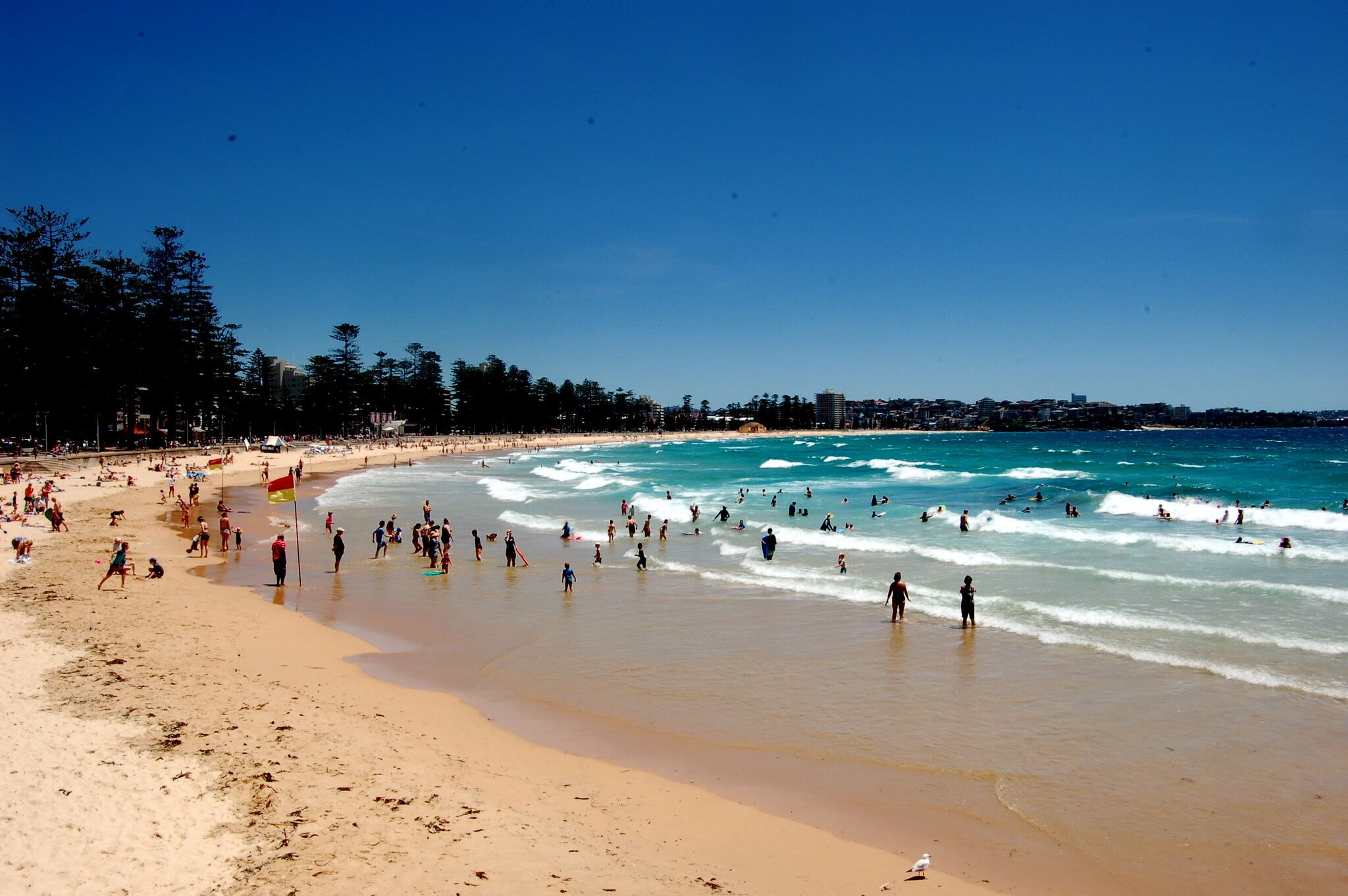
Considered by many to be the best stretch of sand in Sydney, Manly is one of the most popular urban beaches in Australia.
Located 9 miles (14.5 km) from the Central Business District in one of the most attractive and prestigious seaside suburbs in the city, it is easily accessible, and you can get there even by water, getting the regular fast ferry from Circular Quay.
Known for its beautiful promenade dotted with pine trees, Manly Beach is a wonderful place for swimming, sunbathing, surfing, and walking.
This is where the first Australian surf contest ever was held in 1964.
14. Bondi Beach (NSW)

Bondi Beach is the most famous in Sydney and one of the most popular urban beaches in the world.
A symbol of the Australian beach culture and lifestyle, it offers 0.57 mi (0.91 km) of superb soft golden sand.
The beach is very clean and well maintained. It attracts beachgoers, sunseekers, surfers, outdoor sports lovers, and many others.
The beach season is usually between early November and late April, although it can vary significantly from one year to another.
Summers (from December to February) is definitely the peak season, while March and April are known for the most comfortable weather conditions.
15. McLaren Valley (SA)

If you want to feel a Mediterranean touch in Australia, McLaren Valley is a great place.
Situated half an hour drive south of downtown of Adelaide, it is a popular world culinary and wine tasting destination.
The valley is blessed with a balmy Mediterranean climate and fertile soils. That’s why the local varieties of wine grapes are outstanding and are the base of the production of the world top quality wines.
Adding the picturesque landscapes and fantastic white sandy beaches, the valley has become synonymous with good living.
16. Sydney Opera House (NSW)
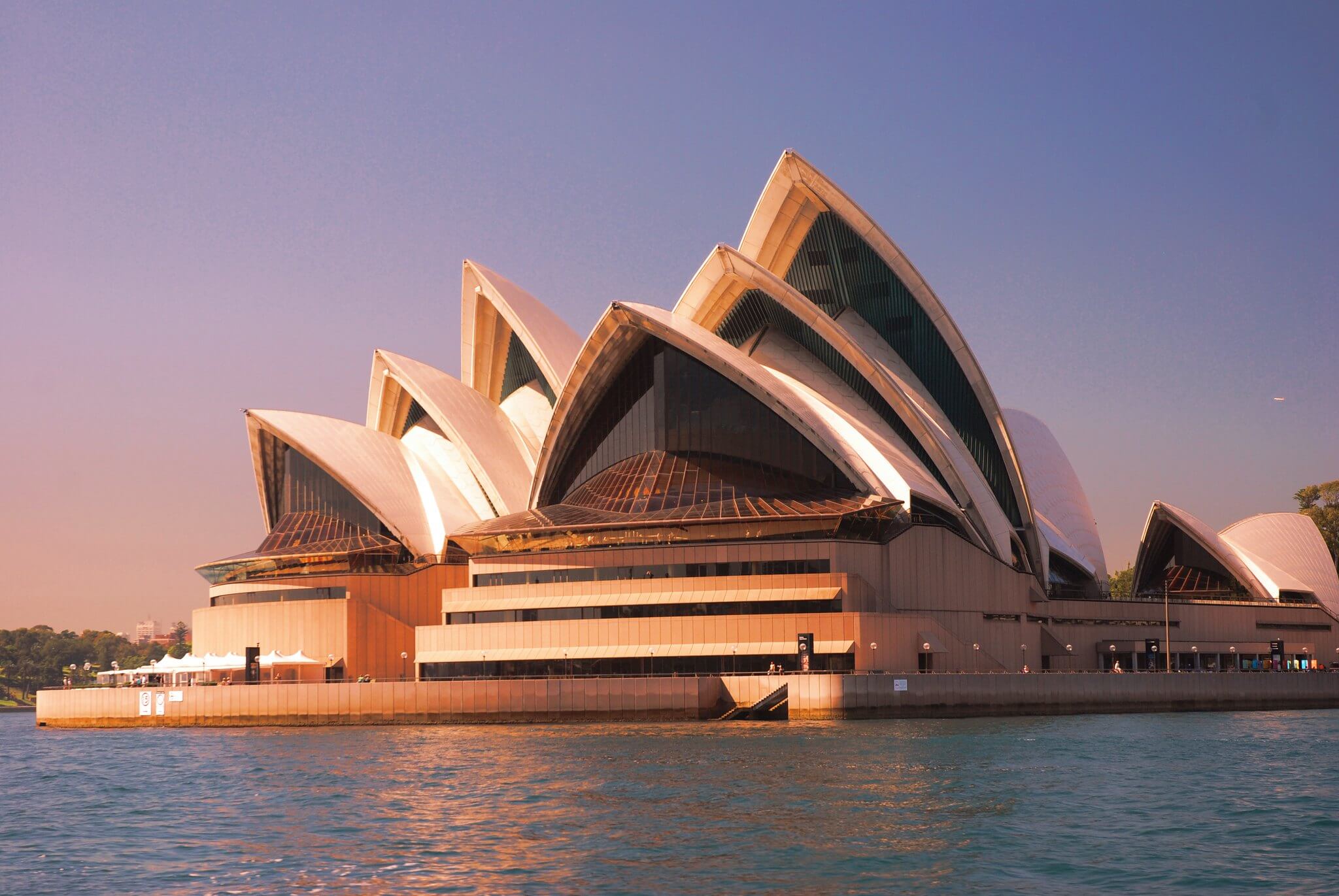
Located on the south coast of Sydney Harbor, the Sydney Opera House is definitely one of the most popular structures on the planet and is the most famous building in Australia.
The groundbreaking took place on March 1, 1959, and the building was officially opened on October 20, 1973, after 14 and a half years of construction.
The structure is 213 ft (65 m) high and is covered with 1,056,006 light creamy-colored and white tiles.
In 2007, the Sydney Opera House was included in UNESCO’s World Heritage List.
17. Sydney Harbour Bridge (NSW)

Gently called the Coathanger, the Sydney Harbour Bridge was constructed between July 1923 and January 1932.
The steel construction has a total length of 3,770 ft (1,149 m) and the clearance under the bridge is 161 ft (49 m).
This is one of the most recognizable and iconic bridges in the world and is the most important transport connection between the Central Business District of Sydney and North Sydney.
One of the most exciting experiences is to join a guided tour and climb the bridge.
Reaching the highest point of 440 ft (134 m), you can enjoy the most amazing panoramic view of Sydney!
18. Karijini National Park (WA)

Situated in Hamersley Range in Western Australia, Karijini National Park covers 627,422 hectares (1,550,390 acres) and is the second largest national park in the country.
Dominated by deep shady red-colored canyons and gorges, the mountain is considered the second oldest in the world with its mind-blowing age of around 3.4 billion years!
Karijini is known for its emerald-green swimming holes, the most famous of which is the Fern Pool.
As there are no crocodiles in this national park, it attracts lovers of swimming, although the water can be quite cold.
Because of its hot and arid tropical climate, the best time to visit the national park is between May and September (the winter season in the Southern Hemisphere).
June and July bring pleasant and comfortable daytime temperatures of around 74°F (23°C). May and August are warmer but not too much and bring pleasant temperatures of around 79°F (26°C).
19. Daintree Rainforest (QLD)

Daintree Rainforest is considered one of the most special in the world.
Situated along the east coast of the Cape York Peninsula in the far north of Queensland, it covers approximately 460 sq mi (1,200 km²) and is the oldest existing forest on Earth.
It is home to at least 920 different species of trees and almost 15,000 species of insects, amphibians, reptiles, birds, fishes, mammals, and invertebrates.
The green oasis is complemented by some of the wildest and untouched beaches in the world.
Most of the forest falls within the borders of the Daintree National Park, which was established in 1988. In 2015, the forest was included in UNESCO’s World Heritage List.
20. Rottnest Island (WA)

Situated 11 miles (18km) off the coast of Fremantle, Western Australia, Rottnest Island is well-known for its fabulous white-sand beaches and shallow turquoise waters.
Offering 25 different species of corals and underwater visibility of between 100 and 130 ft (between 30 and 40 m), this is the perfect place for diving, snorkeling, and swimming.
The island is known for its upscale premium accommodation and is one of the most desirable places to spend your vacation in Western Australia.
As it is blessed with a typical subtropical Mediterranean climate, the best time to visit the island is during the hot, dry, and sunny summer season from late November to April.
21. The Sunken Garden Umpherston Sinkhole (SA)
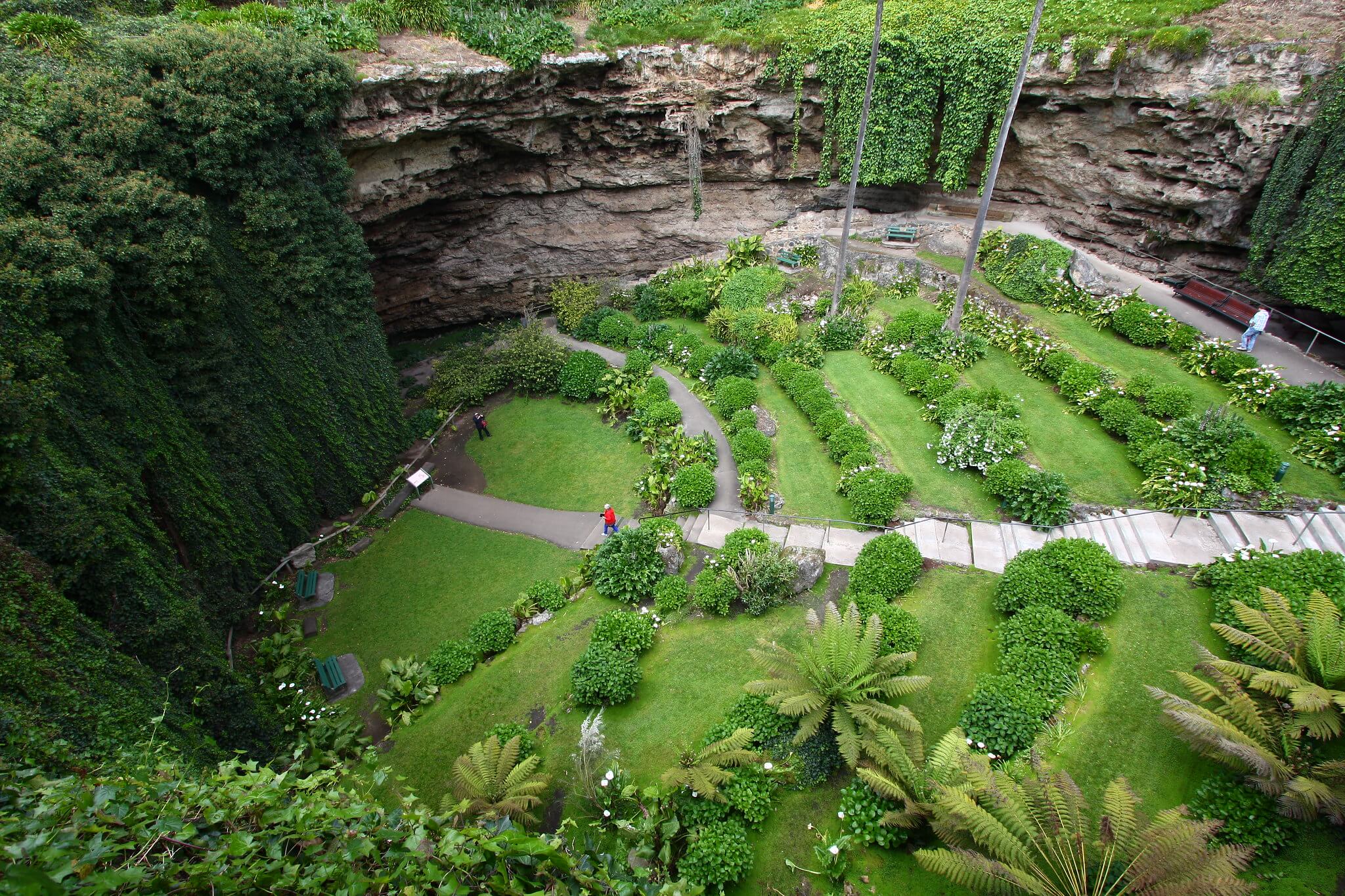
Umpherston Sinkhole or as it is better known as the Sunken Garden is the most important tourist attraction of the small and otherwise quiet town of Mount Gambier, situated in the southeasternmost part of South Australia.
According to scientists, this place was once a completely regular cave.
The sudden collapse of the limestone roof, however, formed a giant sinkhole into the ground.
Approximately 89 ft (27 m) deep, nowadays, it is covered with a lush green garden. The first plants were added in the early 20th century.
Today this is a green oasis with numerous typical local species of plants. The most interesting attraction, however, are the possums living here.
22. Devils Marbles (NT)

Situated in the middle of the extremely hot desert of Outback, in the central part of the Northern Territory, Devil’s Marbles are among the oldest geological formations that can be seen today in the world.
It is estimated that their approximate age is about 1 billion and 500 million years, which is approximately ⅓ the age of the planet Earth itself.
The giant boulders are located within the Devils Marbles Conservation Reserve.
The place is of great cultural importance to the local Aboriginal Australians.
The protected area was established in October 1961. Scattered on a territory of around 7.0 sq mi (18.02 km²), these boulders have become one of the symbols of Australia, and nowadays, this is a very important tourist destination.
The extraordinary rock formation lies 65 miles (105 km) from the city of Tennant Creek, which is a center of an ancient 40,000 years old Aboriginal culture.
23. Mitchell Falls (WA)

Situated in Mitchell National Park, in the far subequatorial North of Western Australia, Mitchell Falls is the main tourist attraction in the area of Kimberley.
Surrounded by red-colored landscapes and sparse savannah-type forests, it is known for its deep emerald-green pools and isolated location.
The waterfall is very difficult to access because of the lack of infrastructure, especially during the rainy season between October and April.
In fact, you can only get there on foot or by air and the best time to do it is during the dry season between May and November.
Swimming in the pools is not permitted because the area is a habitat of the dangerous saltwater crocodiles.
24. Busselton Beach (WA)

Busselton is one of the pearls of Western Australia.
It is located in the southwestern part of the state, within easy reach of one of the famous wine regions of the continent.
It is considered one of the most family-friendly tourist destinations along the west coast due to the clean environment, a wide variety of things to do and because of its extremely smooth azure waters.
The white sandy beaches attract beachgoers and swimmers from late November till early April, with the best weather conditions between late December and late February.
The place has become quite famous for its unique wooden pier, which has an impressive length of 1.2 miles (almost 2 kilometers!).
25. Blue Mountains (NSW)

The Blue Mountains are one of the most extraordinary places in Australia.
Situated 38.5 miles (62 km) west of downtown Sydney, they are well-known for their light-blue color.
The unusual shades are an optical illusion created by the refraction of light as a result of the evaporation of billions of microscopic eucalyptus droplets over the treetops.
Being one of the most recommended tourist attractions in New South Wales, the best time to visit the Blue Mountains is in summer (December, January, and February).
Here you can enjoy outstanding hiking trails, beautiful waterfalls, secluded mountain villages, and many others. Winters sometimes bring heavy snowfalls but are very beautiful too.
26. Barossa Valley (South Australia)

The romantic countryside in the area of Adelaide, South Australia, is known for some of the world’s most fragrant and high-quality premium wines.
The mild Mediterranean climate and rich soils combined with old European traditions create wines that are not inferior to the leading producers from Provence and Tuscany.
In addition, the beautiful Barossa Valley enjoys the reputation of being one of the world’s top culinary destinations.
27. South Bank Beach of Brisbane (QLD)

The South Bank of Brisbane is known as a place that offers a wide range of entertainment opportunities but the main attraction is definitely the white-sand artificial beach, which reveals a stunning view of the skyline of Brisbane.
Situated amidst a beautiful park setting, it is the best option if you want to enjoy some sunbathing and swimming but still don’t want to leave the comfort of the downtown.
Because of the lovely warm and sunny weather in southern Queensland, the beach is open 365 days per year.
28. Wolfe Creek Meteorite Crater National Park (WA)

Situated in the northern parts of Western Australia, not far from the Northern Territory, Wolfe Creek is one of the largest ever found meteorite craters on Earth.
It covers 5.6 sq mi (or 14.6 km²) and was formed approximately 120,000 years ago when a huge meteor (about 49 ft or 15 meters in diameter) hit the Earth.
Today you can still find a crater with a diameter of 2,871 ft (875 m) and a depth of 200 ft (60 m) in the middle of the red-colored semi-arid barren landscape. It falls within Wolfe Creek Crater National Park, which was established in 1969.
29. Magnetic Island (QLD)

Situated only 6.2 miles (10 km) northeast of Townsville, most of Magnetic Island is covered by lush tropical rainforests.
About ¾ of the jungle falls within the limits of Magnetic Island National Park, which was established in 1953 and is home to a huge number of typical Australian species of animals, including koalas and parrots.
In addition to its outstanding biodiversity, the tropical paradise is also known for its azure waters and secluded quiet golden sandy beaches.
The best time to visit the island is the winter season between May and October.
30. North Terrace Boulevard (SA)

Saturated with historical buildings, North Terrace Boulevard is considered the most beautiful and recommended to visit part of Adelaide.
Locked between the vast city’s parklands to the north and the Central Business District to the south, this is the place to find some of the most beautiful and iconic old public buildings in the city, including a number of government and cultural institutions (galleries, museums, libraries) and many others.
Here you can also see the Government House, which was completed in 1840 and is one of the oldest government buildings in Australia as a whole.
31. Lord Howe Island (NSW)

Located 435 mi (700 km) northeast of Sydney, Lord Howe Island is a biosphere paradise with nearly ½ of the flora and fauna consisting of endemic species.
Because of its mild and humid subtropical oceanic climate, the island is covered by lush moist loving evergreen vegetation.
It is known for its snow-white sandy beaches and wonderful coral reefs. The warm and shallow coastal water offers the most irresistible turquoise color you can imagine.
The island is a popular spot for hiking and water sports. Surfing, diving, and snorkeling are among the most popular sports activities.
In order to preserve the natural balance on the island, the maximum permitted number of tourists is 400.
32. Great Otway National Park (VIC)

Great Otway National Park is often called one of Australia’s best-kept secrets.
Isolated in a sparsely populated and remote area of southwest Victoria, along the Great Ocean Road, it covers 103,185 hectares (254,980 acres).
It is a mixture between incredibly beautiful wild rainforests and untouched golden coastline.
Dominated by low mountains and hills, this is one of the rainiest places in Australia.
Not surprisingly, the temperate oceanic climate brings to the forest quite cool weather even in summer with temperatures of around 68 – 70°F (20 – 21°C).
The best time to come here is in July and August when the chances for dry and sunny weather increase.
The rainforest is dominated by fern trees and other moisture-loving species of plants.
The greatest tourist attraction here is the Hopetoun Falls. Almost 100 ft (30 m) tall, this is definitely the most beautiful waterfall in Victoria.
33. Horizontal Falls (WA)

If you want to visit one of the most unusual waterfalls in the world, you have to go to the remote Kimberley Region.
Here, in the northernmost part of Western Australia, two tall and narrow gorges in the McLarty Ranges are the only connection between the Indian Ocean and Talbot Bay.
The openings in the scenic red-colored cliffs are located 1000 ft (more than 300 m) one after another.
Since tides in the region are very high and the amount of water flowing through the gorges is enormous, it forms a powerful stream that looks exactly like a 13 ft (4 m) tall waterfall.
The stream is equally strong during tide and low tide and only the direction of the current is different.
There are only two ways to see this natural wonder – by plane (for example from Broom) or by boat, joining some of the special cruises that operate in the area.
34. Katoomba Falls (NSW)
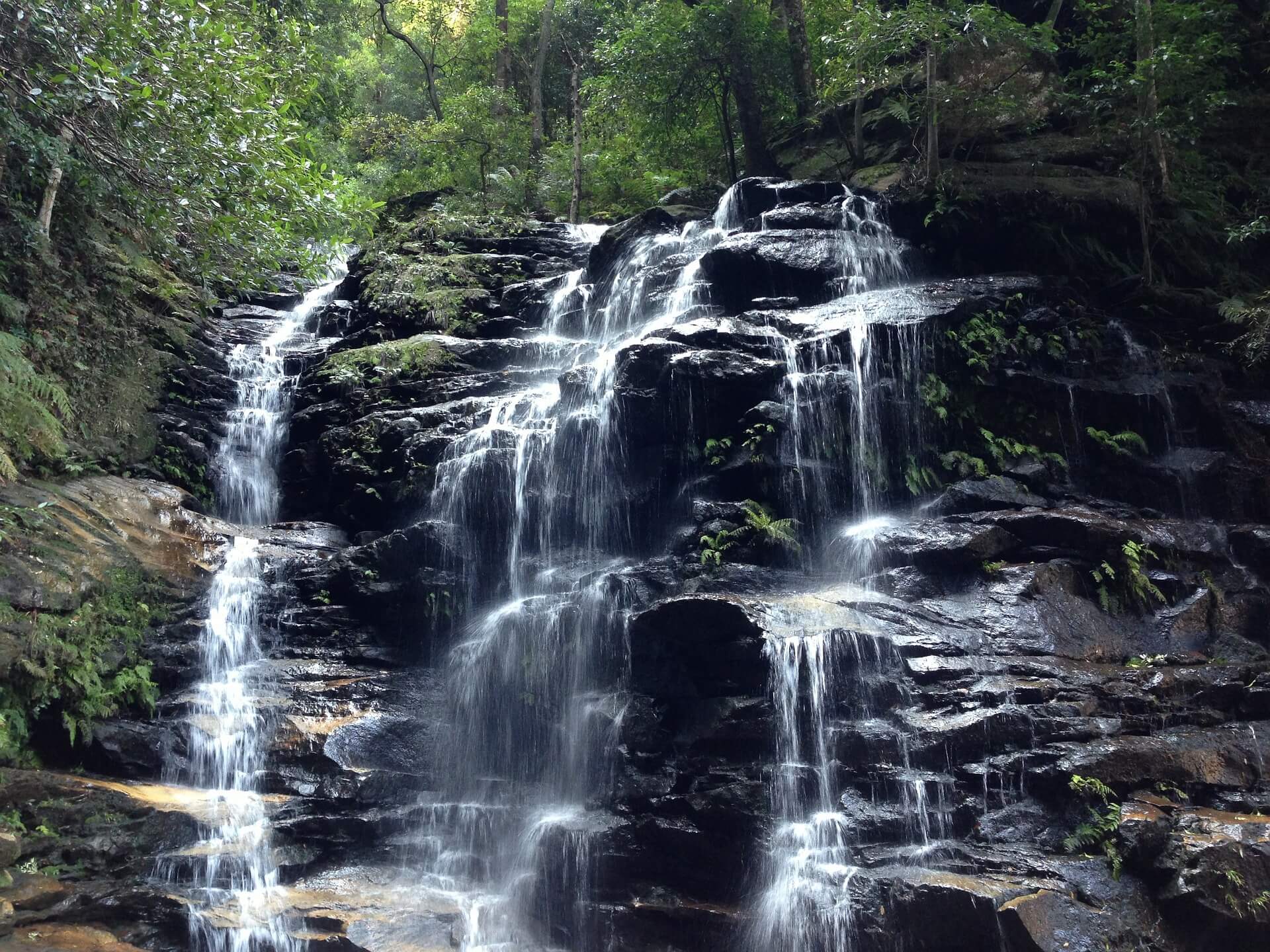
Katoomba Falls is a 755 ft (230 m) tall segmented type of waterfall.
You will find it on the Kedumba River, in the vicinity of the town of Katoomba, New South Wales.
Nestled within the subtropical rainforest of the Blue Mountains, the area offers a number of outstanding forest trails and tourist routes to explore.
As it is only 65 miles (104.6 km) west the downtown of Sydney, one of the most beautiful waterfalls in Australia is very easy to reach. The best time to visit is late spring.
35. Parliament of Australia
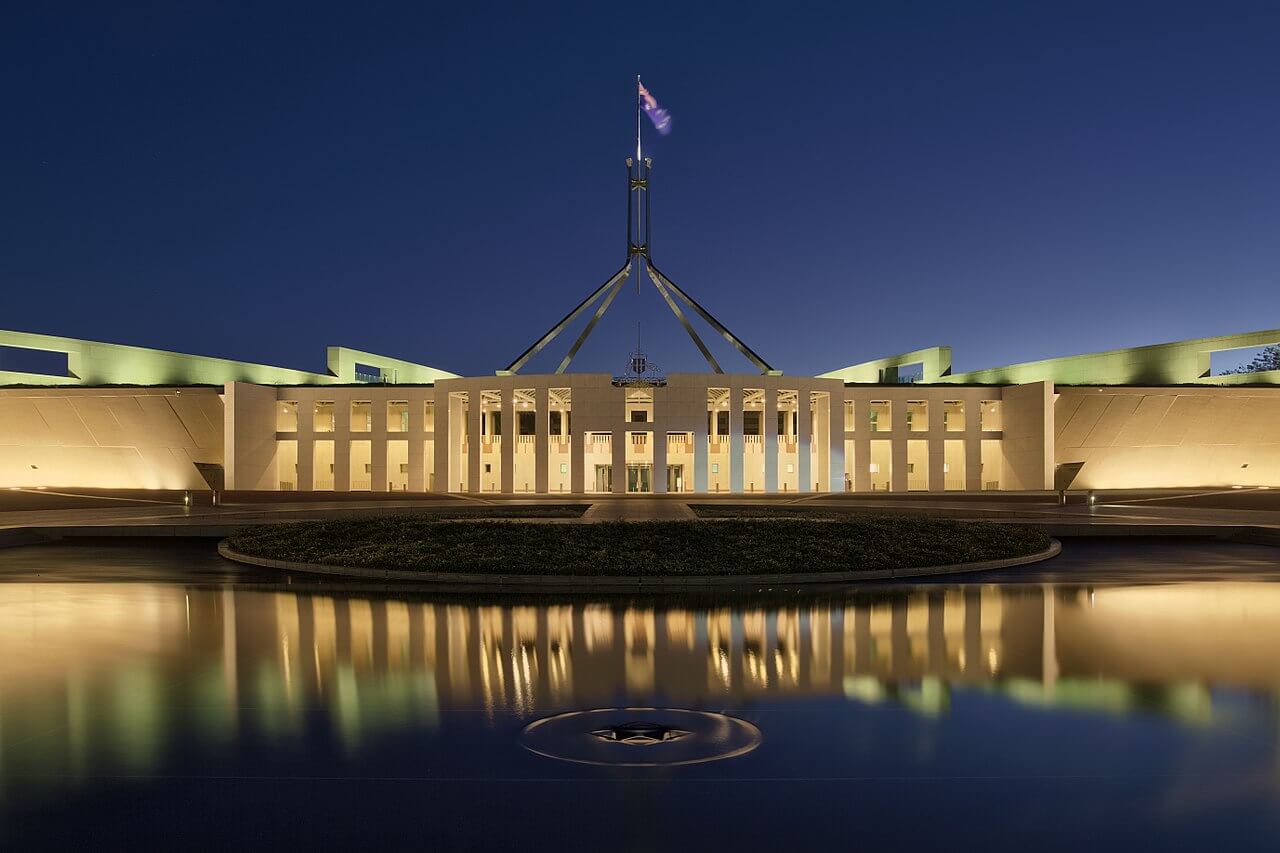
Constructed between 1981 and 1988, the Australian Parliament Building is a unique and unusual structure.
Created by the Italian-born American architect Romaldo GiurgolaIt, the building is situated in the middle of a huge and very beautiful specially created park by Lake Burley Griffin (an artificial lake in the heart of Canberra).
The project has been selected after an international design competition among hundreds of design projects from around the world.
Australian Parliament Building is a unique project. It is part of an artificial hill and is partially buried underground.
The building is topped by a giant stainless steel structure that is 266 ft (81 m) high and complemented by a giant (12.6 by 6.4 meters or 496 by 252 in) Australian flag.
36. Broome (WA)
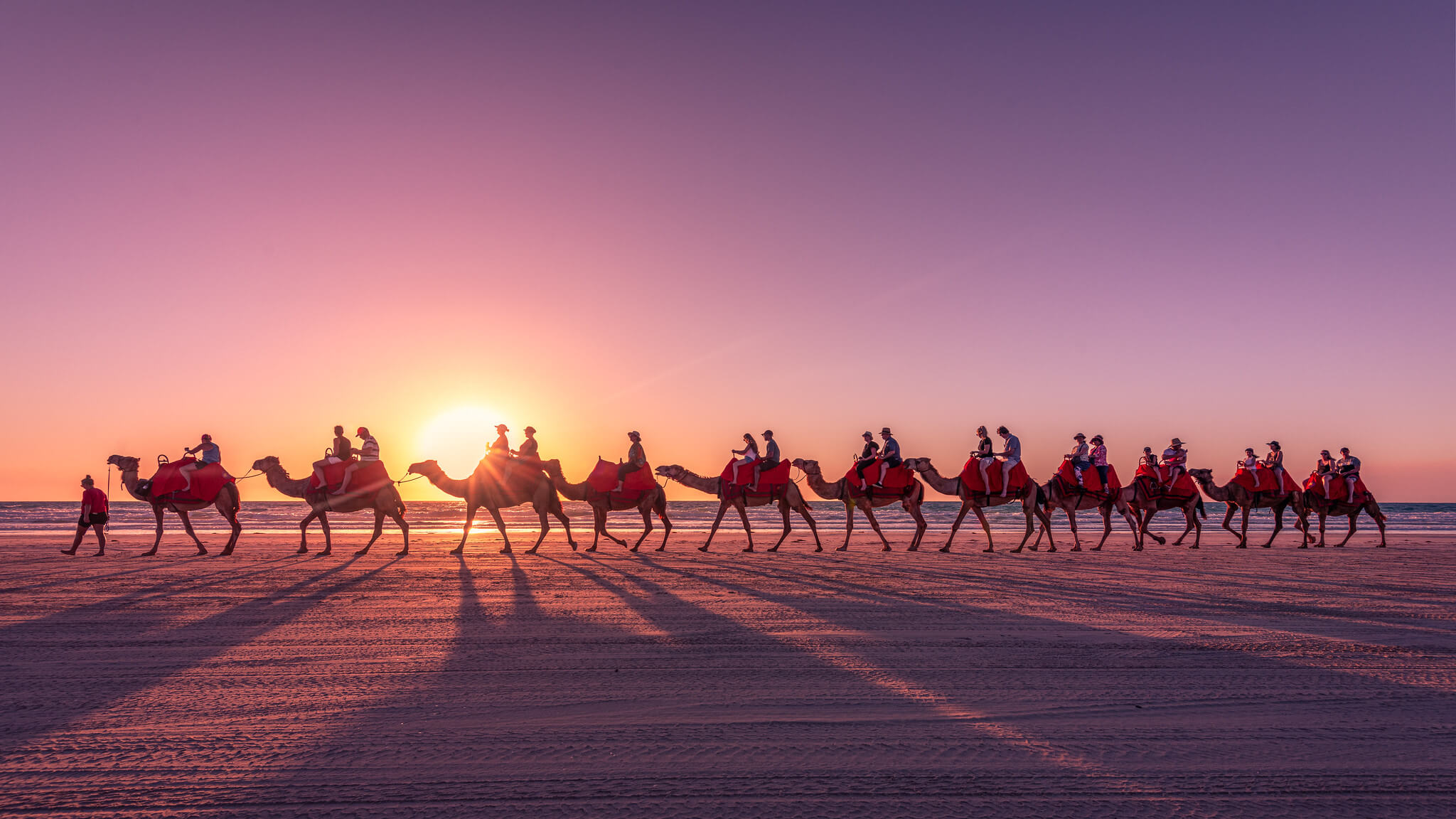
Located in the far north of Western Australia, Broome offers a wide variety of things to see and do.
The palette of colors is dominated by red, orange, white, and turquoise (these are the colors of the rocks, the beach, and the water in the ocean).
It is well-known for its 14-mile (22 km) long white-sand Cable Beach, which is a magnet for beachgoers, swimmers, surfers, snorkelers, and many others.
The place is very popular also for its exciting beach camel tours.
Along the coast, you can find dinosaur footprints that are about 130 million years old.
If you are interested in pearls, Broome is the place for you because here you can buy some of the largest and highest quality pearls in the world.
37. Cradle Mountain National Park and Dove Lake

Located in the interior of northern Tasmania, Cradle Mountain National park is a heaven for lovers of mountain hiking and long walks.
The scenery is a mixture of dramatic cliffs, deep and mirrored mountain lakes, dense rivers, and noisy waterfalls.
Because of its location in the humid temperate far south of Australia, the area sometimes receives intense snowfalls in winter.
One of the most important tourist attractions here is the beautiful Dove Lake. The area of the lake is known for great walking trails.
Since the weather here is usually quite fresh in summer (around 60°F or 15 – 16°C), this is a great option if you want to spend time outdoors.
38. Richmond Bridge (TAS)
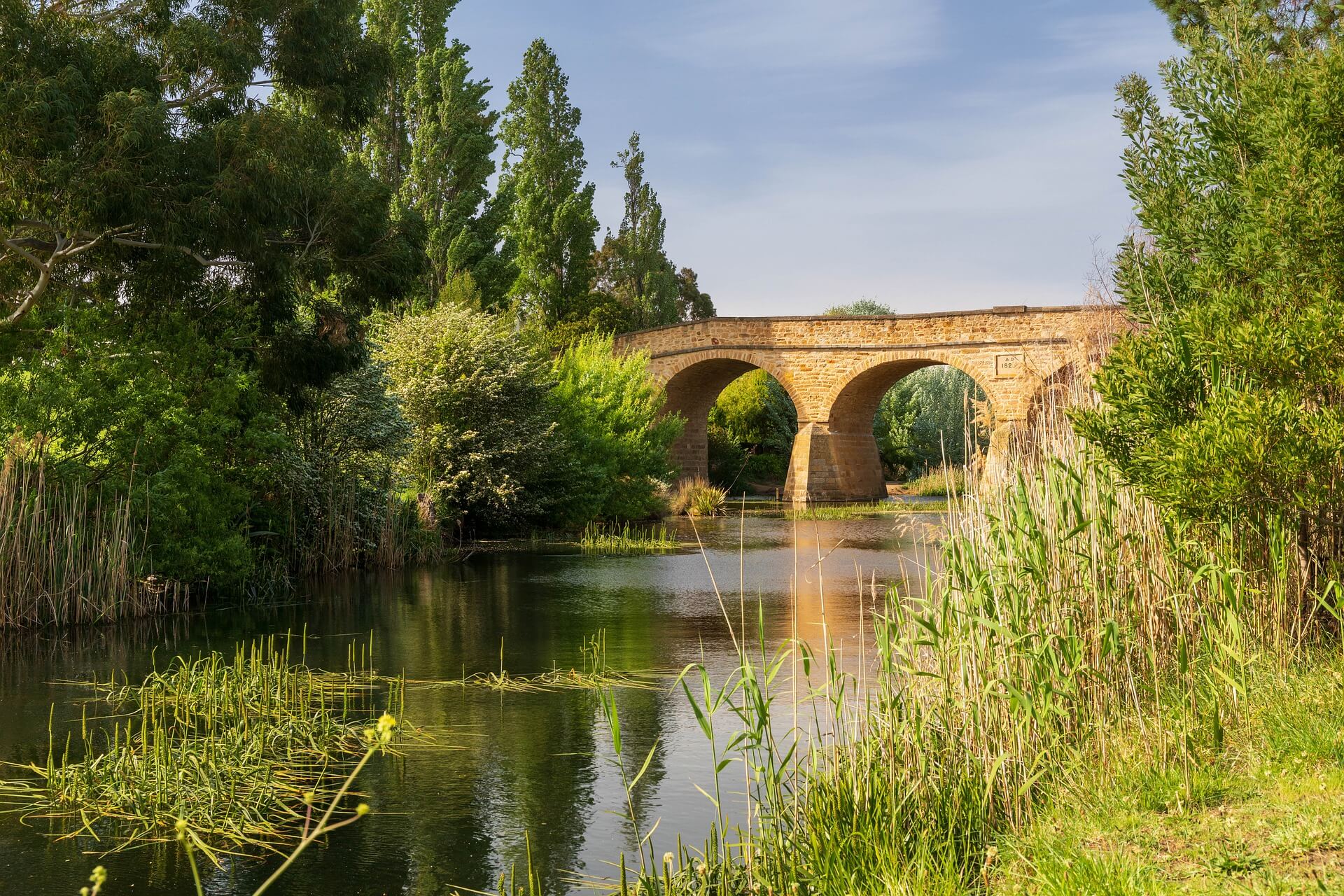
Richmond Bridge is an important heritage site in Tasmania.
You will find it in the small town of Richmond, in the quiet and relaxing countryside of Hobart.
Built by convict labor, the construction took place between 1823 and 1825.
Except for being the oldest stone bridge in Australia, the sandstone structure was the longest on the continent over the next 10 years. The total length of the sandstone structure is 135 ft (41m) and the width is 25 ft (7.2 m).
39. Mary River Floodplains (NT)

Mary River Floodplains is situated 62 miles (100 km) southeast of Darwin, Northern Territory.
The area is dominated by flooded lowlands, home to a number of endemic local species of animals.
The area is an important habitat for hundreds of species of birds, some of which are very rare.
In addition, this is probably the best place to see the huge saltwater crocodiles in their natural environment.
The wetlands fall within the limits of Mary River National Park, which was established on May 20, 1966.
40. Tasman Arch (TAS)

Situated 50 miles (80 km) east of Hobart and right next to the south of Eaglehawk Neck, the Tasman Arch is a huge natural tree-covered bridge.
The opening beneath the arch is 173 ft (52.7 m) high.
Created by erosion, the arch is gorgeous and is a great example of the dramatic beauty of the Tasman Sea coast.
Only two minute walk from the natural bridge is a convenient parking lot. The area is usually very quiet and welcomes a relatively small number of visitors.
41. Ruston’s Rose Garden (SA)

Opened between October 1st and May 31st, Ruston’s Rose Garden is the largest and most beautiful rose garden in Australia and one of the most recommended in the world.
Situated on the outskirts of the small town of Renmark, South Australia, it is known for its incredible diversity of more than 4000 different varieties of beautiful plant.
Here you can find also a wonderful restaurant (you already know that South Australia is a culinary hub!).
42. Byron Bay

Situated on the north coast of New South Wales, Byron Bay is a small town that is known for its outstanding golden beaches.
Being one of the best summer destinations in the state, it attracts beachgoers between November and April when the average temperature during the day is more than 75°F (24°C).
Winters, on the other side, are the best time to walk around because the weather is fresh to pleasantly warm and everything is green.
Byron Bay is home to a number of world-famous celebrities and is a paradise for lovers of surfing.
43. Gippsland Lakes and Ninety Mile Beach

While in Australia, Gippsland Region should be definitely on your travel bucket list.
Situated in southeastern Victoria, it offers a very pleasant and fresh oceanic subtropical climate, which brings mild winters and pleasant summers (the perfect weather to spend time outdoors).
The region is known for the biggest network of inland waterways in Australia, which includes a number of connected shallow lakes and coastal lagoons.
Better known as Gippsland Lakes, they cover approximately 232 square miles (600 km²).
The area is a unique habitat and is known for its huge variety of species of fowl, many of which are endemic.
The network of lakes is a wonderful place for boating and kayaking.
Another tourist attraction is Ninety Mile Beach, which is considered to be the longest uninterrupted stretch of sand in the world.
The beach is quite flat so it is just perfect for walking. Because of its long waves, it is a good choice for surfing too.
44. Karrie Forest

Located in the southwestern part of Western Australia, Karrie Forest is considered one of the most beautiful and well-developed eucalyptus forests in the world.
As a result of the rich soils and favorable climate, many of the eucalyptus trees here are unusually tall, with the forest itself being the tallest in the Southern Hemisphere.
The area is easily accessible and is less than a half-hour drive from the popular Margaret River Wine Region.
45. The Neck (Bruny Island), Tasmania

One of the most unusual and bizarre places to visit in Australia is a huge isthmus that connects the northern and southern halves of Bruny Island.
Called “the Neck”, the 5-mile-long stripe of land attracts many local and foreign tourists to the island with a population of only 600 people.
You will find the isthmus 25 miles (40 km) south of Hobart, in the central part of the small island.
In the northern part of the isthmus, there is a lookout platform that reveals a breathtaking panorama to the south.
46. Jervis Bay (NSW)

Quiet and never too crowded, Jervis Bay is known for some of the best beaches not only in New South Wales but in Australia.
Because of its specific location, the bay is considered one of the most family-friendly and safe swimming places in Australia.
It offers some of the most irresistible soft white-sand beaches and shallow turquoise water.
The smooth and mirrored surface of the water attracts lovers of swimming, snorkeling, and other water sports.
Here you can see a wide variety of sea creatures, including fish schools and dolphins.
The best season for beachgoers is between late November and early March. If you come here in winter, you can see the bioluminescence, also known as Blue Tide.
Because of the bloom of algae, the water sometimes glows blue. The phenomenon can be observed between May and August, although the exact moment is different every year.
47. Esperance (WA)

Located on the south coast of Western Australia, Esperance is a small town but has a lot to offer its visitors.
It is located in an extremely sparsely populated part of the continent, 600 km from Perth and 500 km from Albany.
The place is a very good choice if you want to spend your vacation away from everything.
If you travel across Australia, Esperance should definitely be on your bucket travel list.
The area is famous for the most beautiful beaches on the continent. They are known for their unique snow-white sands and turquoise-blue ocean waters.
Another top attraction in the area is the Sandy Dunes of Wylie Bay – an incredible natural beauty, situated a few minute’s drive to the east of the city.
Because of its geographic remoteness and isolation, the wildlife in the area of Esperance is very well preserved so you can see dolphins, kangaroos, and many other creatures.
48. The Beaches of Fremantle

The port city of Fremantle is known for its unique coastline and superb warm and sunny weather.
Although located on the outskirts of Perth (the largest and most dynamic city on the west coast), Fremantle is famous for its quiet and relaxing pace of life.
The city offers several snow-white beaches that attract a large number of beachgoers and water sports lovers from around the world between October and May every year.
49. Hutt Lagoon / Pink Lake, (Western Australia)

Located on the west coast of Western Australia, right next to Port Gregory, the Hutt Lagoon is a pink-colored 2 ft 2 in (0.65 m) deep salt lake which owes its unusual color to a species of carotenoid-producing algae.
Despite its remote location, it attracts thousands of visitors from around the world.
Better known as Pink Lake, the lagoon is one of the natural wonders of the country.
Although it is only a few minute’s walk from the ocean, most of the lake lies between 3 and 10 ft (between 1 and 3 m) below sea level and covers the bottom of a shallow depression.
50. Yanchep National Park

Situated only 32 miles (about 51 km) north of Perth, Yanchep National Park is a great place to enjoy the outdoors of Western Australia.
Home to a number of endemic Australian species of animals, this is the only place to see koalas on the west coast.
Actually, these animals are not native here. Even so, they are an Australian species, so they find the environment very comfortable and easy to adapt to life here.
The park offers plenty of things to do, including the opportunity to visit sports facilities.
The trails into the park are very well maintained and complemented with easy-to-understand information boards.
51. Tunnel Creek
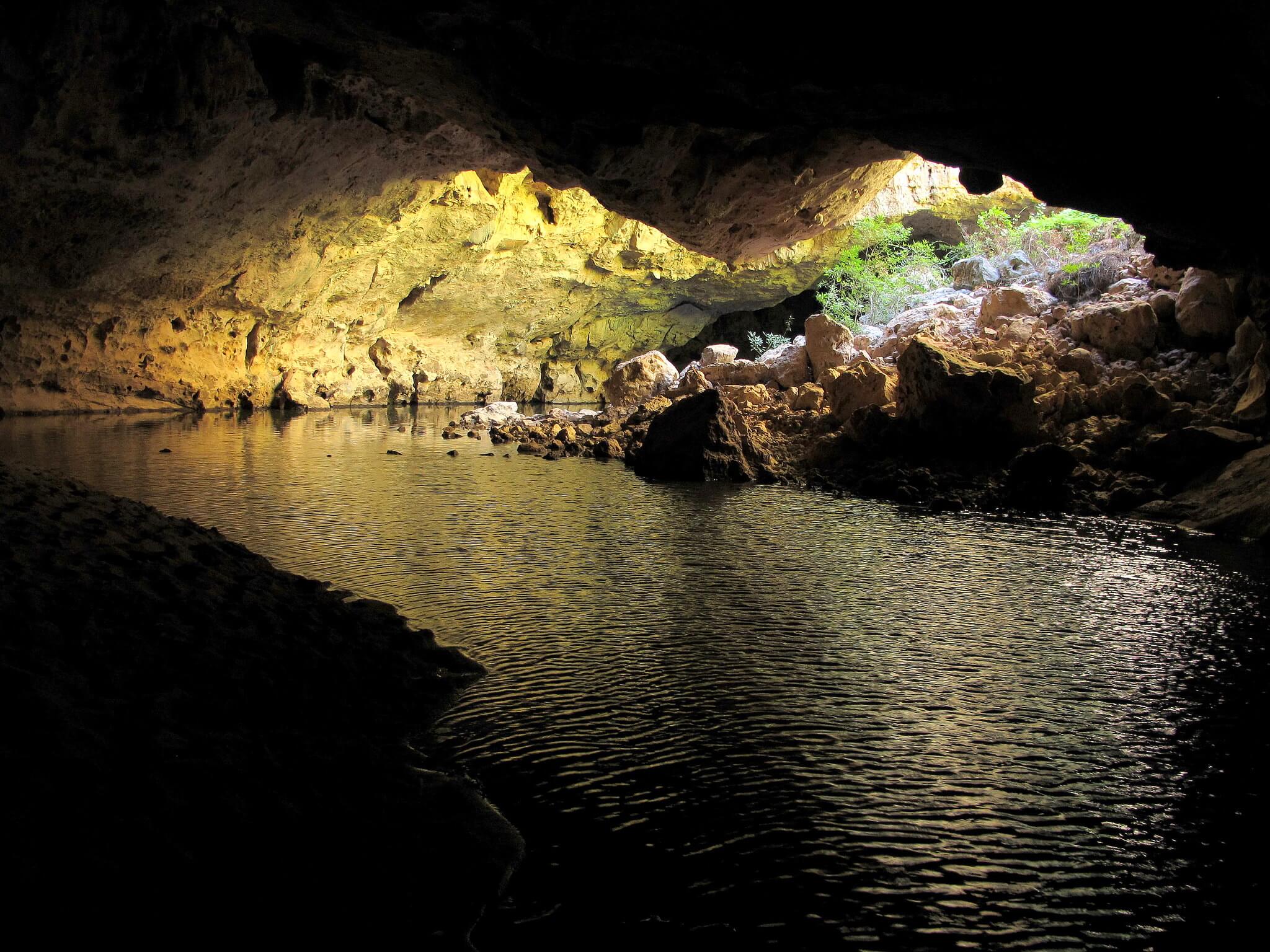
Approximately 350 million years old, Tunnel Creek in the King Leopold Ranges is considered one of the oldest caves in the world.
It is located in the remote and sparsely populated Kimberley Region, in the far North of Western Australia so you can expect very few tourists in the area.
The cave is approximately 2,460 ft (750 m) long with the height of the ceiling of about 33 – 40 ft (10 – 12 m). Parts of the floor are constantly flooded.
Because of the unique natural beauty in the area, 1992 was established Tunnel Creek National Park (Dimalurru). Here you can see a surprisingly rich fauna, with a number of the species being endemic.
52. Cape Range

North West Cape is among the largest peninsulas in the country.
It is situated on the west coast of Western Australia, not far from the popular Ningaloo Reef.
Most of its territory is occupied by the scenic Cape Range National Park, which covers approximately 184.0 sq mi (476.55 km²).
Established in 1965, it is known for its semi-arid tropical landscape, dominated by dry-loving shrubs and some robust species of trees.
The main tourist attraction, however, is the deep Yardie Creek Canyon.
Although it is among the least famous national parks in the country, Cape Range should definitely be on your travel bucket list as it offers an astonishing variety of endemic species of animals, breathtaking views, emerald waters, and red-colored cliffs.
53. Girringun National Park

Situated in the remote and isolated tropical Northeast of Queensland, Girringun National Park attracts mostly experienced hikers with a higher level of fitness.
Although it is situated only 100 miles (160 km) northwest of Townsville, the interior of the park is practically untouched.
The lack of infrastructure and difficult accessibility is a big obstacle for most people to exploring its beauty.
At the same time, this is very good for its tropical rainforest, which is one of the oldest in the world.
The most important tourist attraction of Girringun National Park is the Wallaman Falls. With its 879 ft (268 m), it is the tallest waterfall in Australia.
The national park falls within the Wet Tropics of Queensland, which covers 893,453 ha (3,449.64 sq mi) and was inscribed in UNESCO’s World Heritage List in 1988.
54. Ningaloo Reef

Ningaloo Reef is the second largest in Australia after the Great Barrier Reef.
It is approximately 162 miles (more than 260 km) long and is located along the tropical northwestern coast of Western Australia.
It is one of the best places for swimming, snorkeling, and diving in the world.
The incredible underwater visibility of the turquoise water reaches up to 30 meters and varies between 75 and 83°F (between 24 and 28°C).
Here you can see thousands of species of sea creatures, including almost 300 species of corals and more than 500 species of fishes.
The reef is home to the largest fish on Earth, known as the While Shark. It is known for its peaceful nature and length of about 40 ft (12 m).
Ningaloo Reef was added to UNESCO’s World Heritage List in 2011.
55. Kakadu National Park

Established on April 5, 1979, Kakadu National Park covers 7,646.4 sq mi (19,804 km²) of the Northern Territory.
Situated east of Darwin, the park is a national treasure because of its tremendous biodiversity.
It has a very hot subequatorial climate and the vast territory of the park is covered with marshes and wetlands.
Here you can see the largest species of a crocodile on Earth – the saltwater crocodile, which can easily reach 17 ft (5.2 m).
The rest of the park is covered by subequatorial forests and savannas and is known for its scenic geological rock formations and river canyons.
In 1981, Kakadu National Park was included in the UNESCO World Heritage Sites List.
56. Shark Bay

Situated in the westernmost part of Australia, Shark Bay was included in the list of UNESCO World Heritage Sites because of its unique natural beauty and biodiversity.
This part of Australia is known for its sparsely scattered robust shrubs, red ground, white beaches, and smooth emerald waters.
Due to its unique colors, this place is a great background for photography lovers.
Francois Perón National Park is one of the top attractions in the area. It was founded in 1993 and is located on the largest peninsula of Shark Bay. The park covers an area of 203 sq mi (525.87 km²).
Another attraction is the small resort of Monkey Mia where visitors have the opportunity to interact with dolphins right off the coast.
57. Cape Arid National Park

Located on the sparsely populated south coast of Western Australia, Cape Arid National Park covers an area of 1,078.9 sq mi (2,794.46 km²).
The park is famous for its gorgeous landscape, which is a mosaic of large sandy dunes, snow-white pristine beaches, crystal clear turquoise sea, and typical for this part of Australia’s Mediterranean shrublands.
The area is quite popular with nature lovers, campers, and day trippers from all parts of Australia and from around the world.
58. Darwin City

With a population of 148,564 (as of 2018), Darwin is the most cosmopolitan and busy city in the tropical North of Australia.
It was almost completely destroyed by the monstrous category 5 cyclone Tracy that hit the city on Christmas Eve in 1974. However, Darwin was completely rebuilt in 3 years.
It is known for its unique location amidst the richest endemic ecosystem in the world and is the gateway to the country’s most famous national parks.
The city attracts many tourists from around the world, especially during the dry season between April and September.
Because of its hot and humid climate, it is busiest after sunset when the numerous bars, shops, markets and restaurants are flooded by visitors.
59. Hobart

Founded in 1804 between Mount Wellington and a smooth and sheltered Pacific harbor, Hobart is a picturesque coastal city that attracts visitors for its fresh air, beautiful scenery, and rich history.
Being the busiest city in Tasmania, Hobart offers a wide variety of places to visit, including museums, art galleries, and colorful markets.
Of course, the most pleasant for long walk is the area of the harbor as well as some of the wonderful city parks.
60. Alice Springs

Located in the Red Center of Australia, Alice Springs is a connecting point between east and west and between north and south.
The city falls within the borders of the Northern Territory and is a place with a unique spirit and culture.
Apart from its proximity to the red-colored MacDonnell Range, the city with a population of only about 31,000 is known for its numerous tourist events.
One of the most interesting is the camel race. It is an old tradition and is held every winter in the vicinity of the desert city.
61. MacDonnell Ranges (NT)

The MacDonnell Range is located in the heart of Australia and stretches 400 miles (644 km) in an east-west direction.
Located in the vicinity of Alice Spring, the ridge is one of the oldest and most eroded mountain ranges in the world.
It is estimated to be about 350 million years old, although parts of the mountain are about 2.4 billion years old. Its most distinctive feature is the fiery-red color.
Famous for its deep and cold refreshing swimming holes and deep shady canyons, the place offers a unique Outback experience.
The best time to visit it is during the southern winter, as well as in early spring and late autumn.
Keep in mind that the daytime temperatures are extremely pleasant at this time of year and the skies are clear, but the nights are extremely cold and freezing. Summer, late spring, and early fall are unbearably hot so it is better to be avoided them.
62. Kings Canyon

Kings Canyon is a 330 ft (100 m) deep and well-shaped canyon with vertical red-colored sidewalls.
It is situated in a very remote and isolated semi-arid area in the southwestern part of the Northern Territory.
The red ground in the area is covered with very sparse robust vegetation.
The small Kings Creek meanders at the very bottom of the canyon, nourishing the roots of the trees with its cold waters.
As summers here are scorching, the winter season between April and September is considered the best time to visit this place. It brings temperatures of around 77°F (25°C) in May, 75°F (24°C) in August and 84°F (29°C) in September. June and July bring the lowest temperatures, reaching 70 – 72°F (21 – 22°C) during the day.
The canyon offers three main routes to tourists, and each of the routes reveals the beauty of the canyon from a different angle.
63. Kata Tjuṯa

Kata Tjuṯa is an ancient rock formation located in the Northern Territory, approximately 16 miles (25 km) west of the popular monolith Uluru.
It consists of 36 rock domes, the highest of which rises 1,791 ft (546 m) above the flat surrounding red-colored savannah.
There are various assumptions about the age of the rock formation, but according to the most popular theory, the rocks are at least 500 million years old.
64. Cairns

Surrounded by natural wonders, Cairns is extremely popular with tourists.
It is considered the pearl of the far north of Queensland and is the gateway to the Great Barrier Reef.
It is surrounded by dense tropical rainforests, which are home to rare species of animals, many of which are found only here.
Cairns offer many things to do and see. There are a number of beautiful beaches in the area, the most popular of which are Trinity Beach and Palm Cove.
65. Kuranda (QLD)

Situated amidst the lush tropical rainforest of the wild and remote Cape York Peninsula in northern Queensland, Kuranda is an artistic and charming mountain village.
You will find it approximately 17 miles (27 km) northwest of Cairns, not far from the east coast of the peninsula.
Kuranda is known for its unique spirit and atmosphere, combining local traditions and crafts with the exceptional natural beauty of the mountainous area.
The easiest and fastest way to get to Kuranda is by train from Cairns. The route to the village is dominated by waterfalls, gorges, and rainforests.
At the end of the trip, you stop at the station in Kuranda, where the traditional atmosphere greets you as long as you leave the colorful train.
Kuranda is one of the best places in Australia to buy souvenirs and gifts for your loved ones.
66. Margaret River Wine Region and Mammoth Cave (WA)

With more than 200 private wineries to choose from and 5,000 hectares of vineyards, Margaret River is one of the top wine regions in the Southern Hemisphere.
Situated in the southwesternmost part of Western Australia, it enjoys an incredibly favorable Mediterranean climate.
Except for its top-quality premium wines and fantastic food, the region is also tempting because of its romantic rural landscape, complemented by the scenic coastline and some really fantastic white-sand beaches.
The region is full of natural beauties and wonders and one of them is the Mammoth Cave. Discovered in 1850, it is 98 ft (30 m) deep and 1,600 ft (500 m) long and is one of the top attractions in the region.
67. Barron Gorge National Park

Situated not far from Cairns in the tropical northeast of Queensland, Barron Gorge National Park covers a relatively small area of 28 km² (10.8 sq mi).
It was established in 1940 and is named after the homonymous gorge that occupies most of its territory.
The gorge is covered by lush rainforests and is known for the outstanding Barron Falls, which is one of the most majestic waterfalls in Australia.
Another popular tourist attraction is the emerald freshwater holes, which attract a number of swimmers during the dry winter season.
68. Meander Falls Track (TAS)

The Meander Track is located in the Great Western Tiers Mountains in northern Tasmania.
The place is known as one of the most beautiful tourist routes in Australia.
Being quite difficult, however, it is suitable only for people with a higher level of fitness.
Known for its unique beauty, the area is covered with dense rainforests, dominated by typical native species such as ferns and eucalyptus.
The shady forest paths are especially pleasant in summer, late spring, and early autumn. Snowfalls are possible in winter.
Several waterfalls define the character of the area, and Chasm Falls is undoubtedly one of the most beautiful.
69. Port Douglas (QLD)
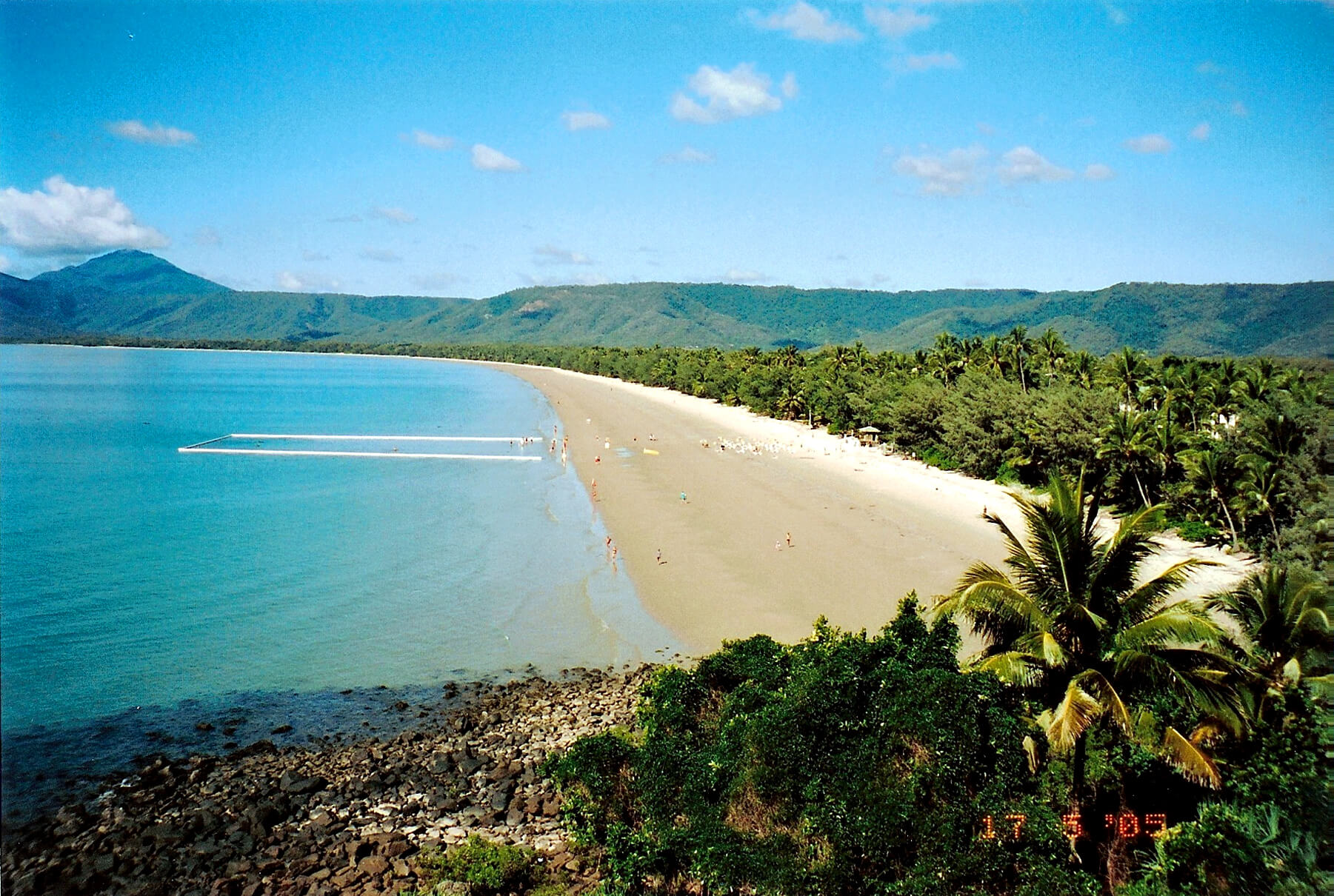
Situated on the coast of northeastern Queensland, right next to the largest coral reef on the planet, Port Douglas is a small town with a population of just over 3,500.
It is blessed with a wonderful tropical climate with daytime temperatures between 77 and 86°F (25 and 30°C) throughout the year.
It is located in the middle of a tropical rainforest, and the coast is famous for its beautiful Four Mile Beach, dotted with thousands of coconut palm trees.
Port Douglas attracts sun-seekers, water sports enthusiasts, and wildlife lovers from around the world. It is considered one of the ten best tropical cities to visit in Australia.
70. Great Barrier Reef (QLD)

Added to UNESCO’s World Heritage List in 1981, the Great Barrier Reef is one of the world’s greatest wonders and Australia’s greatest natural landmark.
As it stretches for more than 1,400 miles (2,300 km) along the coast of Queensland and consists of more than 3,000 separate reef systems, it is extremely difficult to get a real idea of its size and biodiversity.
There are various ways to experience the beauty and the greatness of this wonder of nature but the best ideas are to join a glass-bottom boat trip or to book a helicopter tour over the reef.
The best place to book a cruise or a helicopter tour is Cairns because Cairns is slightly closer, followed by Townsville.
71. Townsville (QLD)

Known for its elegant 19th-century architecture and for the largest coral reef aquarium in the world, Townsville is the gateway to Tropical Northern Queensland.
This is a wonderful place to spend the perfect summer vacation, no matter the season.
The city is very attractive because of its wonderful weather and temperatures ranging between 77°F (25°C) in July and 90°F (32°C) in December.
In addition to its perfect climate, Townsville offers a wide range of things to do and places to visit.
One of the most interesting tourist attractions in the area is Castle Hill, which is a 938 ft (286 m) high granite red-colored monolith situated in the very heart of the city.
72. Billabong Sanctuary

Billabong Sanctuary is located a few minutes’ drive southeasts of Townsville and offers the opportunity to experience the wildlife of Australia in an exciting and safe way.
The park has been created around a natural lake and is home to more than 100 species of iconic Australian animals.
The major attraction is the feeding of the crocodiles, which allows you to see one of the largest and most dangerous predators on the planet.
Here you can also see some amazing local creatures such as koalas, cassowaries, kangaroos, and colorful species of local parrots.
73. Sunshine Coast (QLD)

The Sunshine Coast is an attractive hot spot for beachgoers, surfers, and swimmers but it is also a paradise for nature lovers.
It attracts visitors with its 60-mile-long stretch of superb golden sands, unspoiled subtropical coastal wilderness, and popular tourist town of Noosa Heads.
The climate is very mild and pleasant over the year with the best time to come here being the spring.
It brings the most comfortable temperatures of around 75 – 77°F (24 – 25°C), warm seas, and clear skies. Winters (June, July, and August) are pleasant for long walks but the temperature of between 66 and 70°F (19 and 21°C) can be a bit chilly for swimming in the ocean.
74. El Questro Wilderness Park

Located in the northernmost part of Western Australia, right next to the Northern Territory’s border, El Questro Wilderness Park covers approximately 1,000,000 acres (4,047 km²).
Dominated by subequatorial savannah and scrublands, the area is very remote and isolated.
It is home to a number of endemic species of animals, including Australian saltwater crocodiles in some areas.
One of the most beautiful parts of El Questro Wilderness Park is the Emma Gorge. It is known for its scenic waterfall and two emerald-green freshwater natural pools, better known as the Turquoise Pool and Emma Gorge Pool.
75. Glass House Mountains

Glass House Mountains is an unusual place located in the middle of the rainforest of the Sunshine Coast in southern Queensland.
It consists of 13 mountain peaks of volcanic origin, the highest of which is 1824 ft (556 m) above sea level.
Although not very high, Glass House Mountains are easily recognizable due to their distinctive appearance.
Approximately 27 million years old, they are severely eroded and are mostly covered by lush vegetation.
Today they are one of the must-visit tourist attractions on the east coast of Australia.
76. Gold Coast
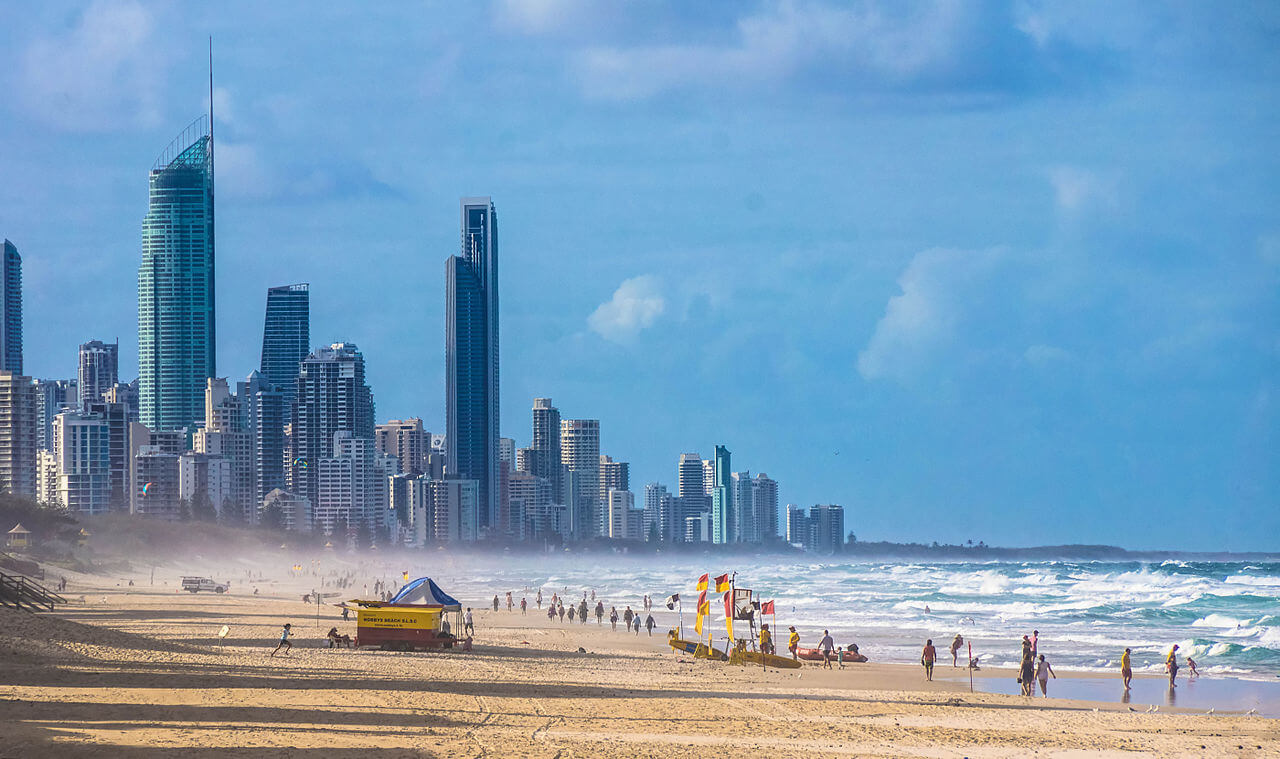
Situated in southeastern Queensland, about an hour’s drive south of the Central Business District of Brisbane, Gold Coast is a thriving tourist center.
The skyline of the city is dominated by some of the tallest skyscrapers in the Southern Hemisphere.
Q1 (1060 ft or 323 m) is the tallest building in Australia and is the second tallest south of the Equator after Sky Tower in New Zealand.
Gold Coast is known for its outstanding sandy beaches which attract beachgoers and surfers from around the world.
The city offers a wide variety of things to do. In addition, the weather is fantastic.
Summers are very long and last from September to May. Winters are a bit chilly for swimming but are perfect for walking and other outdoor activities. The average temperature during the day is about 70 – 72°F (21 – 22°C).
Do not miss exploring the suburbs of Surfers Paradise (busy and entertaining) and Coolangatta (more relaxing and distance to the south).
77. Kalbarri National Park

Situated on the central west coast of Western Australia, almost a hundred miles (160 km) south of Shark Bay and 300 miles (483 km) north of Perth, Kalbarri National Park was established in 1963.
It covers approximately 706.6 sq mi (1,830.05 km²) and is a mixture between scenic coastal cliffs, dramatic river canyons, and extraordinary shaped red-colored eroded rocks.
The main tourist attraction is the red arch, better known as the Nature’s Window. It reveals a breathtaking panorama and is situated only 1312 ft (400 m) from the nearest parking lot.
Another attraction is the Blue Holes on the coast. This is an amazing place to swim and snorkel because of the turquoise crystal clear water and great underwater visibility.
The area offers a really hot semi-arid climate, with temperatures between 72°F (22°C) in July (with quite cold nights!) and 93°F (34°C) in February.
78. Wave Rock (WA)

Situated in a remote area of the southwestern part of Western Australia, in the vicinity of the small town of Hyden, the Wave Rock is an extraordinarily shaped granite formation.
It was formed approximately 27 million years ago and looks like an ocean wave.
Because of its red, orange, grey, and yellow stripes, the rock changes its color depending on the angle of the sun.
In the area, you can see Aboriginal paintings that are thousands of years old.
79. Cervantes (WA)

With a population of only 527 residents (as of 2019), Cervantes is a beautiful small town in the southern part of the Coral Coast, approximately 125 miles (more than 200 km) north of Perth.
It is unique with the fact that most of the streets in Cervantes are named after cities and regions in Spain.
The area is quite popular for its superb white-sand beaches and well-preserved wild nature.
The water in the ocean is crystal clear with turquoise shades and is perfect for swimming and snorkeling.
In addition, the area is characterized by long, dry, and hot summer seasons and warm seas.
The weather is great for sunbathing and swimming between October and May when you can expect clear skies and comfortable temperatures. In fact, some days are good for the beach even in winter!
80. Tamborine Mountain

Situated not far from the Gold Coast, Tamborine Mountain attracts many visitors because of its natural beauty and easier accessibility.
You will find a place less than 50 miles (less than 80 km) from Brisbane.
The 1,722 ft (525 m) high plateau is covered by beautiful subtropical rainforest.
Known for its wonderful waterfalls, the area is a real oasis that offers the opportunity to escape the summer heat.
Because of the altitude above sea level and the lush vegetation, the average temperature during the day in summer is only 77 – 79°F (25 – 26°C).
81. Glenelg Beach (SA)

Glenelg Beach is the most popular and attractive stretch of sand in South Australia.
It is the embodiment of the beach culture and coastal way of life of the residents of Adelaide.
It is famous for its fantastic soft golden sand and mirrored azure waters.
Glenelg Beach attracts beachgoers, swimmers, walkers, joggers, beach volleyball lovers, and many others.
Compared to most other beaches in Australia, it is considered relatively safe and good for swimming.
The sea surface here is quite smooth and big waves or dangerous currents are rare in comparison with Sydney, Gold Coast or Perth for example.
82. Sydney Royal Botanic Gardens (NSW)

Situated between the famous Sydney Opera House and Sydney Business District, the Royal Botanic Gardens is a green oasis in the heart of the big city, on the shores of the most beautiful urban harbor in the world.
Covering an area of 30 hectares (74 acres), the gardens offer the opportunity to experience the Aboriginal Australian culture and see many of the typical plant species of the continent while enjoying a pleasant and relaxing walk.
Opened in 1816, today the garden welcomes over 3.5 million visitors a year.
83. Sydney Luna Park (NSW)

Opened on October 4, 1935, Sydney Luna Park is well known for its extraordinary-looking gate.
Decorated with a face and two side towers, it is definitely the most recognizable amusement park in Australia and in the Southern Hemisphere.
A number of TV shows, movies, and TV series have been filmed here over the years.
Because of its great importance to the city, Sydney Luna Park has been included in the New South Wales Heritage Register.
84. Kangaroo Island (SA)

Kangaroo Island is a magnificent wildlife sanctuary right off the southern coast of South Australia.
It is a mixture of quiet small villages, untouched landscapes, outstanding white beaches, turquoise waters, and wonderful cuisine.
Considering the large distances from one point to another, if you want to explore even the most remote corners of the island and to get the most out of your trip, you should rent a car for your own convenience.
If you are planning a few days here, the best time of the year is between September and December.
85. Taronga Zoo (NSW)

Situated in Mosman suburb, on the north coast of Sydney Harbour, Taronga Zoo is one of the top attractions in the city.
Opened on October 7th, 1916, it covers 28 hectares (69 acres) and is home to more than 350 different species of animals, including the most iconic local species.
Start your experience with the Sky Safari Cable Car, which is the fastest, easiest, and most exciting way to get to the zoo. The cable car is free if you have an entry ticket for the zoo.
If you want to fully enjoy Taronga, you need to spend at least a couple of hours here.
86. SEA LIFE Sydney Aquarium and Darling Harbour (NSW)

Over the years, the vibrant Darling Harbor has become one of Sydney’s most popular and remarkable tourist areas. The place is a hub of nightlife in Sydney. The choice of restaurants, hotels, and clubs is mind-blowing!
Here are some of the most important landmarks of Australia, the most famous of which is the SEA LIFE Sydney Aquarium. Completed in 1988, it is home to approximately 700 species of sea creatures from around the world. The aquarium is a top attraction of the city with more than ½ of its visitors coming from abroad.
87. Melbourne Business District and Eureka Tower (VIC)

A walk in the central business district of Melbourne is an exceptional experience, especially in the evening when the city looks even more impressive than Sydney.
Mind-blowing glass skyscrapers rise along the northern and southern banks of the deep Yarra River.
The most impressive structure is the Eureka Tower, which rises to 975 ft (297.3 m) above the city.
The observing platform called “The Edge” is one of the most recommended attractions in the city. It reveals a breathtaking panoramic view from approximately 935 ft (285 m).
Of course, if you want to enjoy the very best view, you need to visit “The Edge” around and right after sunset!
88. Litchfield National Park (NT)

Situated approximately 75 mi (more than 120 km) south of Darwin, Litchfield National Park covers an area of about 563.1 sq mi (1,458.47 km²).
The landscape is dominated by dramatic canyons and gorges, red ground forested subequatorial savannah, vertical cliffs, and breathtaking waterfalls.
The greatest attraction is the beautiful Wangi Falls, which is a magnet for visitors.
The park is known for its extremely rich flora and fauna, dominated by a number of endemic species of animals and plants.
Saltwater crocodiles are one of the most interesting animal species here. Males can reach a length of about 20 ft (6 m) and up to 2,200 lbs (almost 1,000 kg).
As vast territories are covered by wetlands, the national park offers the perfect habitat for them.
The best time to visit Litchfield National Park is during the dry season between May and September, which brings clear skies and temperatures of around 86 – 90°F (30 – 32°C).
89. Street Art Melbourne Streets (VIC)

Melbourne is one of the most famous places in the world when it comes to street art.
Several of the most famous streets are real free open-air galleries.
Among the most popular places are Hosier Lane located near Federation Square, Caledonian Lane (an intersection of Lonsdale Street), and Center Place an intersection of Flinders Lane and Collins Street.
Most of the art streets are extremely easily accessible and are located within a walking distance of each other in the eastern half of the Melbourne Business District.
90. Brighton Beach Colorful Boxes (QLD)

Situated on the northeast coast of Port Phillip Bay, only a few minutes’ drive from downtown of Melbourne, Brighton Beach is a very attractive place.
In addition to its smooth and warm shallow waters and soft golden sands, it is quite popular for its small and colorful wooden boxes with iron roofs. They were built during the early 20th century but are still very well preserved.
You can see similar structures in other countries around the world, including the United Kingdom, France, and the Baltic states.
91. Brisbane Botanic Gardens Mount Coot-tha (QLD)

Founded in 1970, the Brisbane Botanic Gardens Mount Coot-tha is one of the most important tourist landmarks of the city.
They are located almost 3.5 miles (5.6 km) from the Business District of Brisbane and offer approximately 56 hectares of tropical and subtropical gardens.
One of the main attractions here is the Japanese Garden, which was created in 1988 and officially opened to visitors in February 1989.
Another reason to visit the beautiful Brisbane Botanical Gardens is the Lookout Mount Coot-tha. This is definitely the place with the most mind-blowing view of the city and its incredible skyline!
92. Aquarium of Western Australia (WA)

The Aquarium of Western Australia (AQWA) was opened on April 13, 1988, at Hillarys Boat Harbour, Perth.
Being 130 ft (40 m) long and 66 ft (20 meters) wide, it is the largest aquarium in Australia.
Here you can see approximately 400 species of typical Australian marine creatures, but probably the most interesting are the exhibits in the so-called Danger Zone, which is home to sea snakes, saltwater crocodiles, different species of sharks, and many others.
93. Brisbane Central Business District (QLD)

The Central Business District of Brisbane is a beautiful mixture of old and new buildings.
Modern shopping centers and mind-blowing skyscrapers are situated right next to old churches from the 19th or early 20th century, and the contrast is unbelievable.
One of the greatest tourist attractions is the Story Bridge which spans the Brisbane River. Opened on July 6, 1940, it reveals a wonderful view of the skyline of Brisbane.
The city is a magnet for visitors as it offers plenty of things to do and see.
Despite its majestic appearance, everything is within a walking distance in the Central Business District.
The best way to end the day is to visit some of the great local restaurants, bars, and clubs.
94. Nitmiluk National Park (NT)

Nitmiluk National Park is located south of Kakadu National Park.
Known for its exceptional biodiversity, the park is home to a wide variety of species of birds and mammals, many of which are endemic.
Here you can also see the giant saltwater crocodile, which usually does not move away from rivers and other bodies of water.
The biggest attraction is undoubtedly the picturesque Katherine Gorge, which is located at the extreme southern end of the park and is considered about 23 million years old.
95. Moreton Island and Tangalooma Wrecks (QLD)
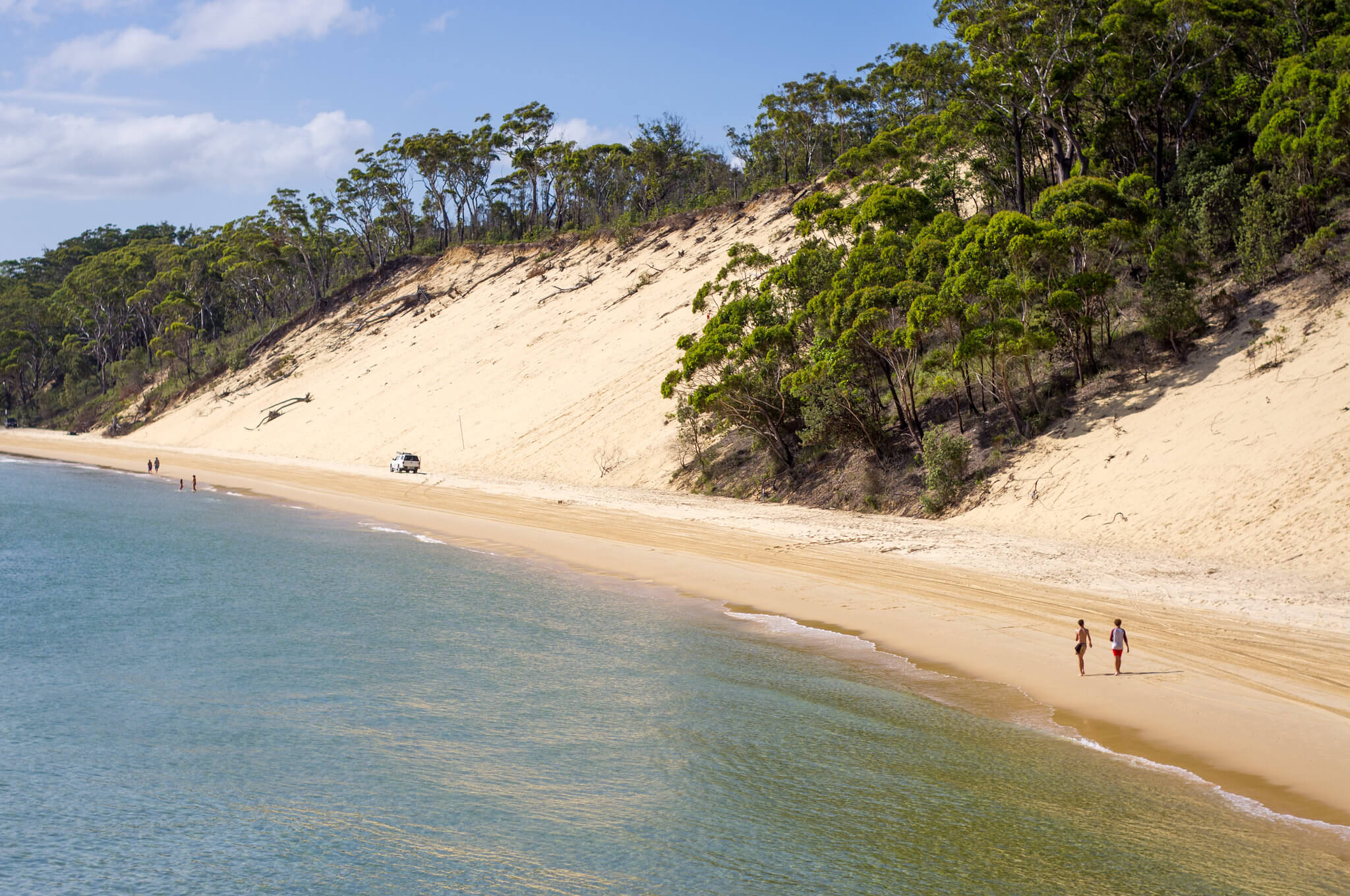
Located 36 miles (58 km) off the coast of southern Queensland, Moreton Island is one of the sandy islands that are so typical of this part of Australia.
Almost entirely covered with eucalyptus forests, 98% of the island’s area is occupied by a national park.
The coastline is uniquely beautiful as it offers some of the most irresistible soft golden sandy beaches you have ever seen.
The west coast of the island which faces Moreton Bay, attracts many lovers of swimming and water sports because of its warm and mirrored crystal clear emerald waters.
In addition to its unique nature, Moreton Island is famous for the Tangalooma Wrecks, which are a popular place for diving and snorkeling. The place is extremely interesting and is located not far from Tangalooma, right off the west coast of the island.
96. Yanchep Lagoon (WA)

Perth offers a number of great places for swimming and snorkeling in the area but one of the best spots definitely is the Yanchep Lagoon.
Situated more than 30 miles (almost 50 km) north of the Central Business District of Perth, the lagoon is known for its turquoise waters and incredible underwater visibility of between 100 and 130 ft (between 30 and 40 m) in clear and windless sunny summer days.
Home to hundreds of species of sea creatures, the reef offers incredible biodiversity.
The best time to visit this wonderful beach is, of course, the summer season between October and March.
97. Swan Valley (WA)

Just a few miles northeast of Perth, you find yourself in a completely different world, dominated by the sneaking Swan River and the region’s fertile vineyards.
The mild Mediterranean climate and rich soils in the area are a very good base for the production of premium quality wines, which rank among the best in the world.
If you visit Australia in October (this is the early spring here), do not miss the festival “Spring in the Valley”, which is one of the most popular foods and drink festivals in the Southern Hemisphere.
98. Perth Central Business District

Dominated by modern architecture and glass skyscrapers, the Business District of Perth is relatively compact and easy to explore within a pleasant and leisurely stroll.
The downtown is a true masterpiece of the modern urban environment.
Comfortably situated on the north bank of the meandering Swan River, it is extremely clean, convenient to move from one point to another, and picturesque.
In the vicinity, you will find beautiful parks, botanical gardens, and extensive green areas.
99. Kings Park (WA)

Located just southwest of the Perth Business District, Kings Park is the largest city park in the world.
Established in 1831, it covers an area of 400.6 ha (990 acres) and stretches along the north bank of the sneaking Swan River.
Bigger than even New York’s famous Central Park, Kings Park is a place where you can spend the entire day outside, enjoying the wonderful nature, fantastic Mediterranean climate, tranquil alleys and trails, sculptures and many others.
100. Mount Field National Park (TAS)

Dominated by one of the most beautiful and preserved rainforests in Australia, Mount Field National Park covers an area of 62.8 sq mi (162.65 km²) in the heart of southern Tasmania.
Most of the territory of the park is covered with ferns and locally endemic species of plants.
Due to the heavy rainfalls and sometimes snowfalls over the year, you will find beautiful mountain lakes, deep rivers, and spectacular waterfalls.
The most famous of them and the most interesting for tourists are respectively Russell Falls, Lady Barron Falls, and Horseshoe Falls.
As the climate here is very fresh and pleasant, the park offers some of the most tempting and enjoyable hiking trails in Australia.

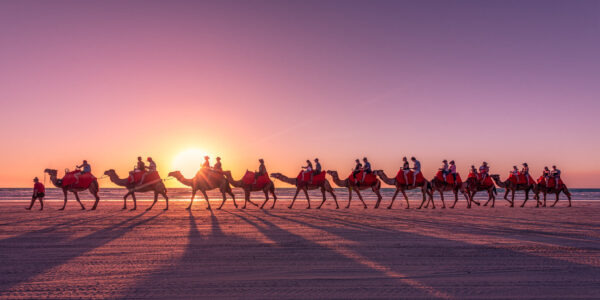
 For all latest news, follow The carefulu Google News channel.
For all latest news, follow The carefulu Google News channel.




